Twelve top industry suppliers share their cutting-edge solutions, valuable insights and what’s next for the business of ant management for pest management professionals (PMPs). We also want to hear from you: What are your go-to ant strategies, and what new approaches are on your radar?
B&G, a Pelsis Group Brand
Anna Iversen, BCE, U.S. technical director
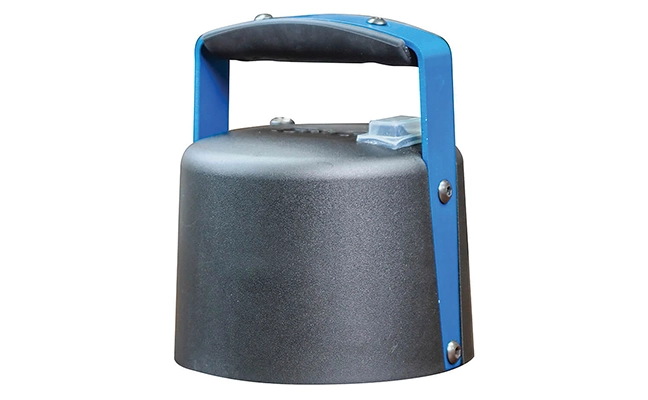
Recent innovations: The B&G Pressurizing Tank Top (PTT) replaces the B&G Primeline tanks’ hand pump assembly, maintaining consistent pressure without manual pumping. That means every pull of the trigger delivers the same flow rate and droplet size. Residuals and repellents go down at the label required rate instead of the “best guess” that comes with declining tank pressure.
The PTT has been a great new tool for ant management, because uniform applications save products, reduce callbacks and shorten stop time.
Other features include:
- The PTT retains optimal pressure (25 to 30 pounds per square inch, or PSI) in the sprayer from the time it is filled to when it is empty.
- It attaches to the top of B&G Primeline tanks.
- It saves an estimated 5 minutes per gallon, reducing fatigue on every job.
- Its long-lasting rechargeable battery provides up to four hours of continuous use, between 27 and 30 gallons.
- Conveniently charge on-the go with the included car charging adapter.
- A tank lid for secure closure is also included for use while the PTT is being charged.
Predictions: We are seeing a trend where ant control is shifting away from broad perimeter sprays and toward precise spot treatments. This means chemical formulations are applied exactly where they are needed for effective control. We expect this precision trend to accelerate.
BASF
Sylvia Kenmuir, BCE, senior technical services representative, professional & specialty solutions
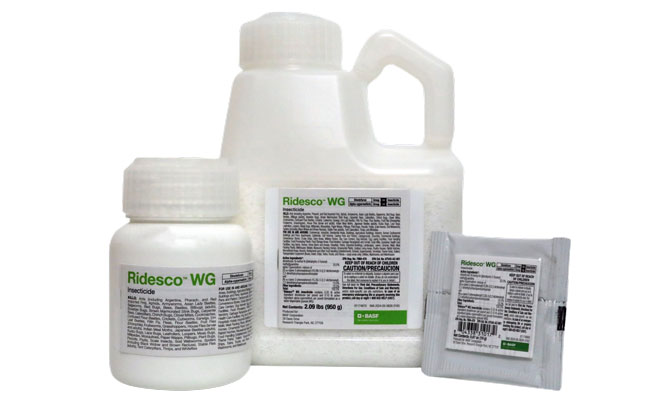
Recent innovations: Take a two-step attack on ants with help from BASF.
1. Nonrepellent liquid applications. Hit fast, but don’t scare them off. Nonrepellents are key because anything that spooks the ants can cause colony budding, exacerbating the problem. Top BASF solutions include Termidor SC termiticide/insecticide, Alpine WSG water-soluble granule insecticide, and PT Phantom II pressurized insecticide. These products move slowly enough to avoid alarms. Alpine WSG and Termidor SC have the added bonus of a transfer effect, spreading deep into the colony. New tools like Ridesco WG insecticide (pictured) can offer a quick knockdown option, but be smart: Keep it away from bait zones to avoid cutting off the ants’ movement to baits.
2. Better baiting. Baiting isn’t about wiping out the workers you see; it’s about taking down the larvae and the queens you don’t see. Use slow-acting Advance 375A granular ant bait to make sure it gets passed around the whole colony. It’s labeled for odorous house ants (Tapinoma sessile, or OHA) and pharaoh ants (Monomorium pharaonis), but field studies show it’s also tough on rover ants (Brachymyrmex patagonicus) and Asian needle ants (Brachyponera chinensis).
Fun fact: A Clemson University study (Benson and Joon, 2020) found that texture matters just as much as taste. Ant larvae can only digest solid food at the fourth instar. Get bait near larvae, and you’re getting close to the queen.
Predictions: These strategies are effective, but they aren’t instantaneous. Setting customer expectations early is critical. Let them know we’re not just chasing ants; we’re taking out the colony.
Control Solutions Inc.
Sam Pass, PCO division director
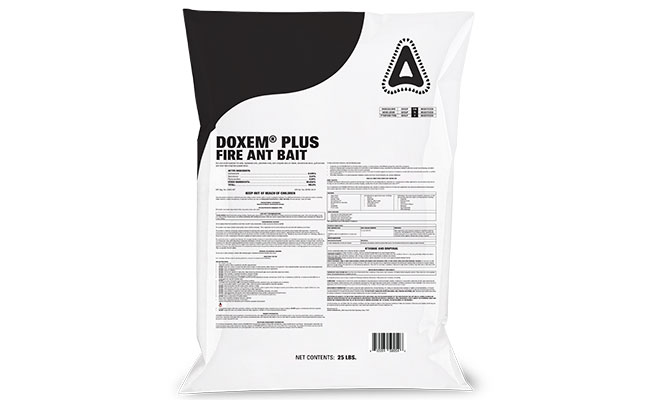
Recent innovations: Control Solutions Inc. (CSI) continues to develop new solutions to simplify ant control. Our liquid concentrates, aerosols and baits can help PMPs get better results with fewer visits.
Our latest ant control product is Doxem Plus Fire Ant Bait (pictured). This ant bait granule is highly attractive to imported fire ants (Solenopsis spp.) as well as big-headed ants (Pheidole megacephala), pavement ants (Tetramorium immigrans) and turfgrass ants (Lasius neoniger). It is designed to manage difficult ant populations by killing the queen and the entire colony. Better still, it is not a restricted-use product (RUP).
In addition, Doxem Precise is a dry flowable bait designed for use with the Precision Delivery System (PDS). The dry flowable formulation and proprietary applicator enable PMPs to more effectively treat cracks, crevices and voids where ants may harbor or gain entry. The bait is durable and long-lasting, so a single application can help maintain control over time.
Doxem NXT aerosol, meanwhile, combines four nonrepellent active ingredients (AIs) and is compatible with baits and other nonrepellent applications, making it an ideal tool in an ant management program. It has a broad label that allows for applications in food-handling establishments and other sensitive areas, making it a great option for ant control in almost any setting.
Predictions: Ant control always has been a challenge for PMPs. The traits that make ants, especially tramp species, so successful make them particularly hard to control. There will never be a “silver bullet” solution for all ant species, but continued innovation will make ant identification and control simpler for technicians. Combination products, various new formulations and more accessible resources will help ensure results.
Ensystex
David Newfang, ACE, PHE, technical sales representative
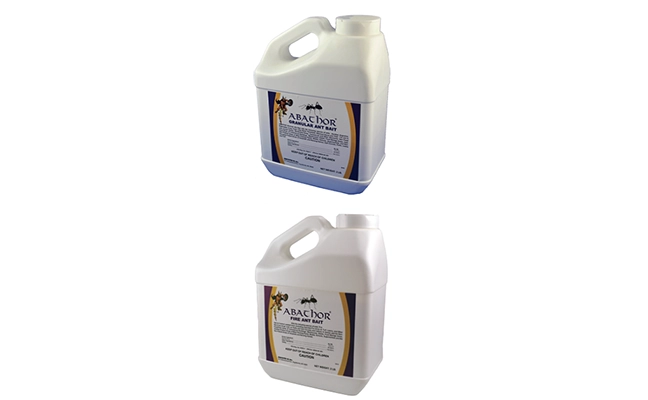
Recent innovations: At Ensystex, precision and practicality drive our approach to pest management — and our Abathor line is a clear reflection of that. Designed for professional use in both structural and landscape environments, Abathor products deliver effective control against a wide range of ant species using a proven active ingredient (AI): abamectin B1.
Abathor Granular Ant Bait is formulated to eliminate a variety of common household and nuisance ants, including OHA, pavement, Argentine (Linepithema humile) and little black (Monomorium minimum) ant species, among others. With just 0.011 percent abamectin, this slow-acting bait exploits ant foraging behavior, enabling worker ants to carry the granules back to the colony for widespread impact. It’s labeled for use both indoors and outdoors, including residential areas, warehouses, hotels, schools and non-patient zones of healthcare facilities. It’s also ideal for green spaces, such as parks, golf courses and lawns.
For fire ants, Abathor Fire Ant Bait offers a focused solution. Also featuring abamectin B1 at 0.011 percent, this product targets fire ant colonies at their source. It’s labeled for use on turf, lawns, and other non-crop areas and is effective indoors in commercial and residential buildings. The bait is available in a large, economical 25-pound bulk size, making it a practical choice for treating large properties such as golf courses and public landscapes where fire ants can pose serious safety concerns.
Both formulations work by exploiting natural ant behavior, delivering abamectin directly into the heart of the colony. This means better control, longer-lasting results and less disruption to treated areas.
Predictions: As the ant control market continues to expand, Ensystex remains committed to providing PMPs with effective, scalable and field-tested tools. The Abathor line is built for performance, whether you’re treating a lawn, a schoolyard or a storage facility.
Innovative Pest Control Products
Sarah Bernard, entomologist and owner
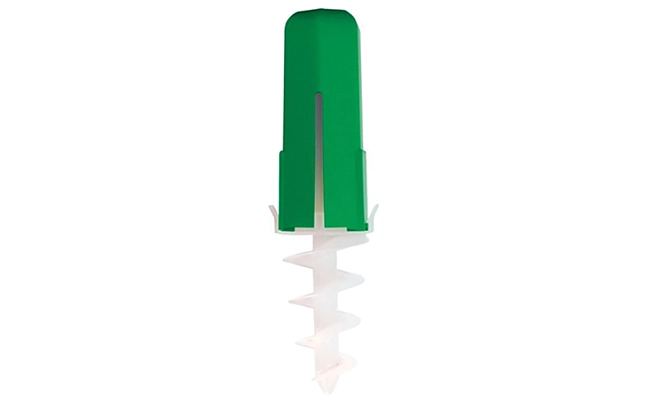
Recent innovations: Innovative Pest Control Products has been supporting PMPs with effective ant management tools for more than 24 years. Our philosophy is simple: Use ants’ natural behaviors to carry slow-acting toxicants back to the colony, where they can eliminate the queen(s) and disrupt the population at its source.
Our Antopia 6 Bait Station (pictured) is designed specifically for colony elimination. It holds up to 6 ounces of liquid or granular bait, is protected by an ultraviolet light (UV)-resistant cover, and includes a screw-in anchor for secure, above-ground placement. Its high capacity minimizes service visits while protecting bait from rain and sprinklers.
For faster indoor relief, gel baits with quicker-acting AIs are ideal. Gourmet Ant Bait Gel, which contains
6 percent disodium octaborate tetrahydrate (DOT), has been trusted for more than two decades to provide effective knockdown of foraging ants.
To extend bait life and improve delivery, we offer two versatile stations:
- Ant Cafés are pet- and child-resistant, using a zip-tie-style closure for safety and double-sided tape for secure placement.
- BugBar Bait Stations are compact, cost-effective and ideal for countertop use. Their textured ramps and clamshell design make them attractive to ants and cockroaches while protecting bait from contamination and evaporation.
Predictions: Ant control will continue to be a steady revenue stream. As global temperatures rise, we anticipate changes in the distributions of ant species. However, invasive tramp ants with large colonies and multiple queens will likely continue to dominate, keeping the demand for effective, colony-focused solutions strong.
MGK
Dr. Ryan Neff, technical field specialist
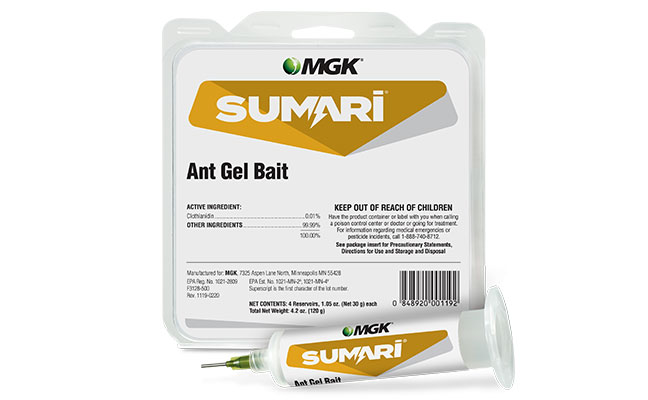
Recent innovations: MGK’s newst innovation in ant control is Sumari Ant Gel Bait. It’s formulated with clothianidin, a powerful neonicotinoid designed to deliver colony-level control through ingestion and trophallaxis. This bait is part of the broader Sumari System, built to streamline ant control across a wide range of structural environments.
Sumari Ant Gel offers high palatability and consistency, making it an ideal choice for use in various conditions. Foraging ants consume and share the bait with nestmates, allowing clothianidin to spread throughout the colony, including the queens and brood. The result is not just the knockdown of workers but the complete disruption and collapse of the colony.
PMPs appreciate its non-drip formulation, long-lasting attractiveness and ability to hold up in indoor and outdoor settings. The gel applies cleanly, stays where it’s placed and delivers reliable performance without mess or odor. It’s ideal for use in sensitive accounts such as commercial kitchens, healthcare facilities or multi-unit housing.
Predictions: MGK anticipates a continued shift toward targeted, low-impact control solutions that deliver maximum effectiveness with minimal disruption. Ant control will increasingly rely on bait-based approaches, particularly those that can be integrated into broader integrated pest management (IPM) programs and be rotated for resistance management.
With growing regulatory pressure on older chemistries and rising customer expectations for cleaner, more sustainable products, the demand for nonrepellent, slow-acting baits like Sumari will expand. New formulations of existing chemistries and new additions may become increasingly important.
Neogen
Andrew Fisher, BCE, PHE, business unit specialist
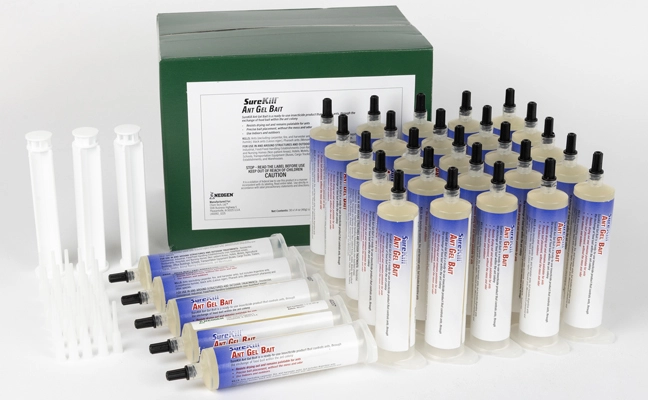
Recent innovations: Neogen is excited about our recent collaboration with PMPs on the redesign of our case packaging for SureKill Gel baits (pictured), which meets the increased demand for sustainable packaging and reduced plastic waste. Our new SureKill Gel Bait 30-packs reduce up to 1.5 pounds of plastic waste compared to the industry average, thanks to our 40-gram fill size in standard syringes and the elimination of unnecessary clamshell packaging. We are proud to be a leader in reducing our carbon footprint while providing excellent products, such as our SureKill Ant Gel bait, to PMPs.
Selecting the right gel bait can be time-consuming and frustrating, especially when your job requires a single product that meets the majority of your needs.
The SureKill Ant Gel Bait was formulated specifically for this purpose and, when paired with the SureKill Gel Bait Pro Applicator, precision placement is achieved.
Other features include:
- Industry-trusted imidacloprid in low concentrations provides effective control throughout the entire colony.
- The SureKill Ant Gel Bait matrix is balanced with sugars and proteins, making it appealing to various species of ants and helping to reduce consumption time.
- Hygroscopic properties within the matrix help increase moisture retention and provide extended foraging opportunities after application.
Predictions: Ant control remains a leading cause of callbacks year after year, posing a constant challenge for PMPs. Extensive technician training on species identification and product choice will continue to be one of the most important aspects of controlling and achieving success in ant management. As product selection evolves, PMPs must rely on multiple modes of action and bait formulations to maximize control. Neogen is committed to continued innovation within the SureKill product line and providing technical support to ensure PMPs are prepared for the demands in the field.
Nisus
Dr. Jamel Sandidge, BCE, national director of technical services
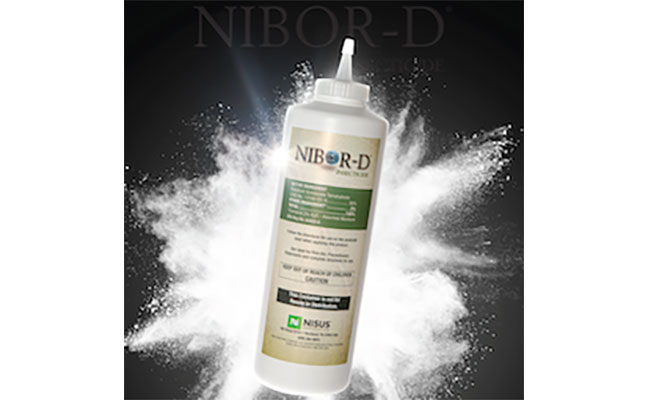
Recent innovations: Ant callbacks are a revenue killer. When ants are the call, the detective work begins, and it’s time to start investigating why they’re there in the first place. Even if you use a perimeter spray, ants can cross the treatment zone when they are actively trailing and searching for food. However, we all know the callback is imminent if a perimeter treatment is the first and only line of defense while ants are in wall voids, protected under mulch or thatch, and building nests in gutters, behind brick, in potted plants, around gardens, under landscaping rocks and timbers or in other protected areas. When ants are in these areas, liquid applications may fail because they can travel underneath these treated layers. Therefore, locating where ants are nesting on the first trip is essential.
In these circumstances, a multi-faceted approach is your best bet to avoid callbacks. Try applying a nonrepellent, long-lasting dust like Nibor-D (pictured) or a fine granular bait such as Niban-FG into any voids and crevices to help reduce the risk of callbacks.
You also can take advantage of ants’ internal drive to forage for food continuously. Ants prefer liquids, so try adding DominAnt Liquid Bait on your first visit. It’s highly attractive and allows ants to bring the bait back to spread throughout the colony.
Plus, Niban Granular Bait features weather-resistant granules that withstand heat and sunlight,. By applying it around the structure perimeter and other problem areas — such as on or near wood piles, garden areas and tree stumps — you can once again use ants’ foraging instincts to help eradicate the colony.
Predictions: Invasive ant species will continue to be a problem in multiple regions across the country. This issue makes species identification even more crucial in establishing control over an infestation.
Pest Control Insulation
Chris White, sales & business development manager
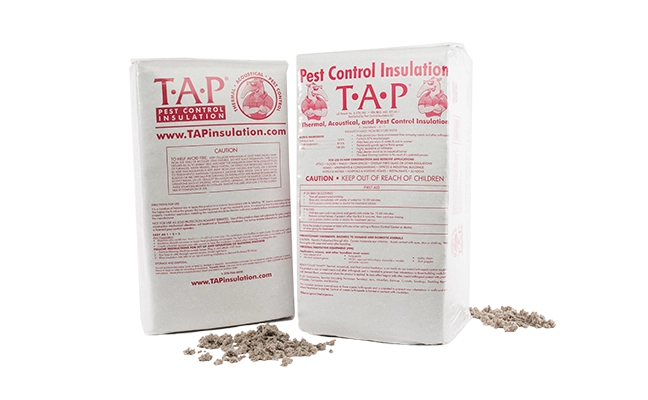
Recent innovations: Unlike kitchens or bathrooms, which offer ants food and moisture, attics can provide them with shelter and warmth — especially in cooler months.
Ants often enter attics through small openings, such as gaps in roofing, vents and eaves. They may seek refuge in insulation, wooden beams and cardboard storage boxes. Once established, they may venture deeper into the home, drawn by accessible food sources.
Carpenter ants (Camponotus spp.), in particular, pose a greater threat, as they burrow into wood, potentially damaging structures. Other species, such as OHA, seek out sugary substances and can quickly spread once they are inside.
To prevent ants from migrating into living spaces, inspect the attic for signs of an infestation, such as wood shavings or ant trails. Work with your customers on sealing entry points, removing potential nesting materials, storing food securely and insulating with TAP Pest Control Insulation. As a pesticide registered by the U.S. Environmental Protection Agency, TAP is an excellent IPM component, stopping ants as they travel through the insulation.
Predictions: Ant populations are influenced by climate changes, habitat availability and human activity. Warmer temperatures and urban expansion can lead to increased ant infestations in homes, as ants seek shelter and food sources. Argentine ants, fire ants and other invasive ant species may continue to spread in certain regions, disrupting local ecosystems.
Advancements in pest control methods, including eco-friendly solutions like TAP, may help manage ant populations more effectively. However, as ants adapt to new environments and food sources, PMPs must remain vigilant in implementing prevention strategies.
Rockwell Labs
Dr. Cisse Spragins, founder and CEO
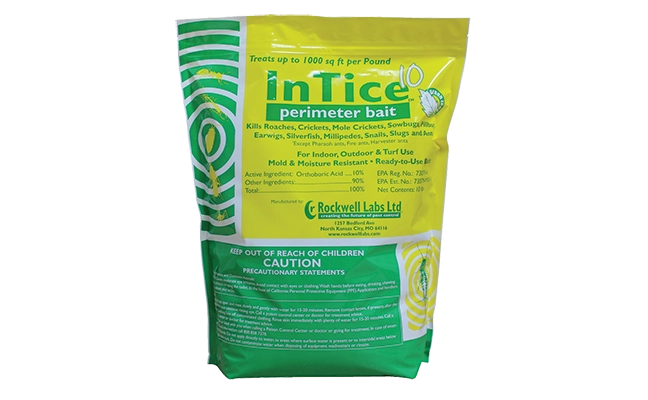
Recent innovations: Rockwell offers several widely used ant control products, of which InTice 10 Perimeter Bait (pictured) is our best-known. As a granular bait with 10 percent boric acid, it shines as a regular perimeter treatment to help control ant colonies before they can develop into major problems. With long-lasting weather resistance, it’s perfect for extended service intervals. A combination of sweet, oil and protein attractants gives it broad-spectrum palatability.
InVict Xpress and InVict Blitz are granular baits that feature 0.5 percent imidacloprid for lightning-fast control. Both baits offer a rich and highly palatable food matrix that also contains weather-resistant particles, providing a combination knockdown and a longer-lasting effect. With a use rate as low as 4 ounces per 1,000 square feet, they also are an economical choice.
InVict Xpress is a broader-spectrum product, like InTice 10, and controls other common perimeter pests, such as crickets, cockroaches, earwigs and silverfish. InVict Blitz has a bait matrix particularly targeted to mega-colony species such as Argentine and tawny crazy (Nylanderia fulva) ants.
Rockwell’s patented InTice Gelanimo Ant Bait features borax in an exclusive “rigid gel” matrix similar to gelatin. It provides ants with the sugar and moisture they crave but is spillproof, quick and easy to use. Plus, ants cannot drown in this bait, which would cause them to emit an alarm pheromone to deter other ants. The palatable, non-dripping gel also is available in a syringe for use in crack-and-crevice areas and on vertical surfaces.
Predictions: Ants remain the No. 1 structural pest. That’s unlikely to change, given their significant impact on the revenue of pest management firms. Because of this market importance, we expect that novel products will continue to enter the market, featuring different AIs, novel formulations and innovative methods of use.
Syngenta
Dr. Tim Husen, BCE, PHE, PCQI, technical services manager, professional pest management
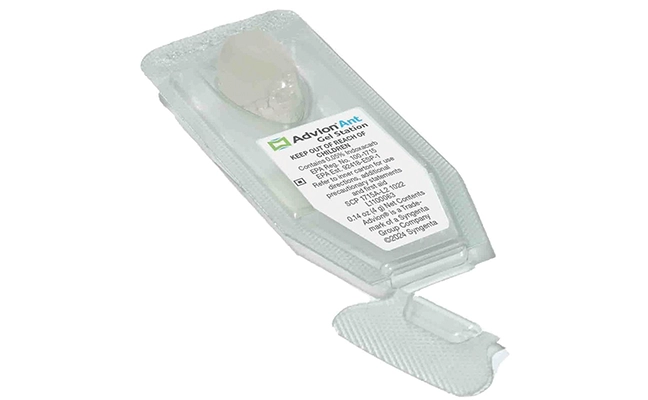
Recent innovations: The latest nuisance ant management tool from Syngenta, the Advion Ant gel station (pictured), is a ready-to-use solution containing the popular Advion Ant gel bait. This station can add value to service offerings as a unique leave-behind product to help prevent ant resurgences between scheduled treatments or for situations where typical bait applications are not desired.
Advion MicroFlow insect bait is another recent nuisance ant management tool from Syngenta. It provides an alternative to traditional gel baits that can reach deep into voids, cracks and crevices where ants nest and forage. It’s finely milled, enabling applications with commonly used dusting equipment, such as electric dusters or bulb and bellows dusters. To prevent cross-contamination, use separate application devices for repellent (amorphous silica/silicon dioxide) or acute-kill (pyrethroid) dusts and nondeterrent products like Advion MicroFlow.
Predictions: Be on the lookout for new nuisance ant control products in the future. The regulatory clock is ticking on many currently used ant control sprayable products, formulations, AIs and their structural use patterns. Finding viable candidates to fill these potential gaps is essential. Newly formulated bait and liquid insecticide products containing brand-new, nondeterrent AI classes will be a big step in the right direction.
We expect nuisance ant management toolboxes to become even more diverse in the next five years. Structure-infesting ants, in particular, are not one-tool pests. PMPs should continue to incorporate new products, AIs and formulations (such as dry flowable baits) into their management strategies while also increasing use of pest ant identification-based physical, mechanical, cultural and sanitation control options.
Zoëcon
Mel Whitson, director of sales & marketing, pest control
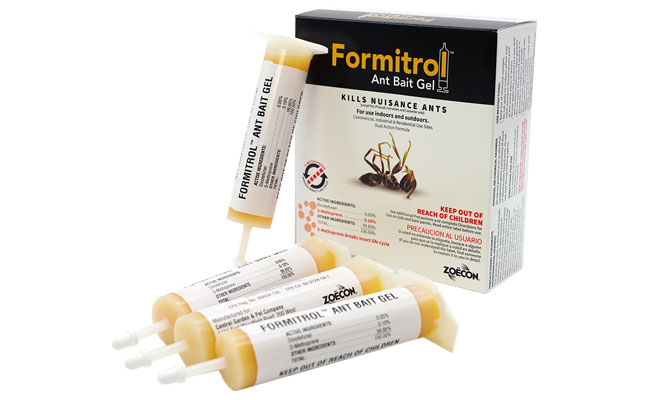
Recent innovations: Ant infestations are among the most common and frustrating issues PMPs face today. Whether they’re invading residential kitchens, industrial warehouses or outdoor recreational spaces, ants continue to challenge even the most seasoned PMPs with their adaptability and colony persistence.
Formitrol Ant Bait Gel is designed to combat nuisance ants with efficiency. The formulation combines two powerful AIs: our (S)-methoprene and dinotefuran. This creates a dual-action bait for comprehensive control.
Approved for indoor and outdoor use on residential, industrial and commercial sites, Formitrol Ant Bait Gel comes in a syringe format for precise applications. This low-odor, sugar-based formulation aids in colony management of over 20 ant species, including acrobat (Crematogaster spp.), ghost (Tapinoma melanocephalum) and rover (Brachymyrmex spp.) ants.
Predictions: Looking ahead, the ant control market is poised for continued growth. Industry trends indicate an increase in infestation pressures over the next five years, driven by rising moisture levels, shifting weather patterns and the emergence of new or invasive ant species. These changes will require PMPs to stay agile and proactive in their treatment approaches.
Zoëcon Professional Products is committed to supporting PMPs through these evolving challenges. With innovative solutions like Formitrol Ant Bait Gel, we’re focused on helping PMPs stay one step ahead — delivering products that provide precise control and reduce callbacks. As conditions change and infestations rise, PMPs can rely on Zoëcon Professional Products to deliver the tools and technology needed to take down ant problems at the source quickly, cleanly and completely.
Leave A Comment